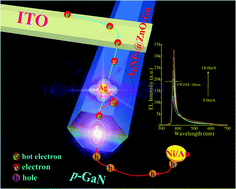当前位置:
X-MOL 学术
›
Nanoscale Adv.
›
论文详情
Our official English website, www.x-mol.net, welcomes your feedback! (Note: you will need to create a separate account there.)
Hybrid quadrupole plasmon induced spectrally pure ultraviolet emission from a single AgNPs@ZnO:Ga microwire based heterojunction diode
Nanoscale Advances ( IF 4.7 ) Pub Date : 2020/02/24 , DOI: 10.1039/c9na00777f Xiangbo Zhou 1 , Mingming Jiang 1, 2 , Yuting Wu 1 , Kunjie Ma 1 , Yang Liu 1 , Peng Wan 1 , Caixia Kan 1, 2 , Daning Shi 1
Nanoscale Advances ( IF 4.7 ) Pub Date : 2020/02/24 , DOI: 10.1039/c9na00777f Xiangbo Zhou 1 , Mingming Jiang 1, 2 , Yuting Wu 1 , Kunjie Ma 1 , Yang Liu 1 , Peng Wan 1 , Caixia Kan 1, 2 , Daning Shi 1
Affiliation

|
Ultraviolet light-emitting materials and devices with high-efficiency are required for many applications. One promising way to enhance the ultraviolet luminescence efficiency is by incorporating plasmonic nanostructures. However, a large energy mismatch between the plasmons and the light emitters greatly limits the direct realization of light enhancement. In this work, a single Ga-doped ZnO microwire prepared with large-sized Ag nanoparticle (the diameter d ∼ 200 nm) deposition (AgNPs@ZnO:Ga MW) was utilized to construct a high-performance heterojunction diode, with p-GaN serving as the hole injection layer. In addition to enhanced optical output, the emission spectra also revealed that typical near-band-edge (NBE) emission with higher wavelength stability centered around 378.0 nm was achieved, accompanied by narrowing of the spectral linewidth to around 10 nm. Thus, the interfacial and p-GaN emissions were successfully suppressed. The spectral profile of the emission spectra of the heterojunction diodes precisely matched the photoluminescence spectrum of the single ZnO:Ga MW, which indicates that the single ZnO:Ga MW can act as the active region for the radiative recombination of electrons and holes in the diode operation. In the emission mechanism, hybrid quadrupole plasmons induce the generation of hot electrons, which are then injected into the conduction band of the neighboring ZnO:Ga and are responsible for the NBE-type emission of the single MW based heterojunction diode. This novel emission enhancement and modulation principle can aid in the design and development of new types of luminescent materials and devices with high-efficiency, spectral stability and spectral purity.
中文翻译:

混合四极等离子体激元从单个 AgNPs@ZnO:Ga 微线基异质结二极管诱导光谱纯紫外发射
许多应用都需要高效的紫外发光材料和器件。提高紫外发光效率的一种有希望的方法是结合等离子体纳米结构。然而,等离激元和发光体之间较大的能量失配极大地限制了光增强的直接实现。在这项工作中,用大尺寸的 Ag 纳米粒子(直径d∼ 200 nm) 沉积 (AgNPs@ZnO:Ga MW) 用于构建高性能异质结二极管,其中 p-GaN 作为空穴注入层。除了增强的光输出外,发射光谱还显示,实现了以 378.0 nm 为中心的具有较高波长稳定性的典型近带边缘 (NBE) 发射,同时光谱线宽缩小至 10 nm 左右。因此,成功抑制了界面和 p-GaN 发射。异质结二极管发射光谱的光谱分布与单个 ZnO:Ga MW 的光致发光光谱精确匹配,这表明单个 ZnO:Ga MW 可以作为二极管中电子和空穴辐射复合的活性区域手术。在发射机制中,混合四极等离子体激元诱导热电子的产生,然后将其注入相邻的 ZnO:Ga 的导带,并负责单 MW 基异质结二极管的 NBE 型发射。这种新颖的发射增强和调制原理有助于设计和开发具有高效率、光谱稳定性和光谱纯度的新型发光材料和器件。
更新日期:2020-03-19
中文翻译:

混合四极等离子体激元从单个 AgNPs@ZnO:Ga 微线基异质结二极管诱导光谱纯紫外发射
许多应用都需要高效的紫外发光材料和器件。提高紫外发光效率的一种有希望的方法是结合等离子体纳米结构。然而,等离激元和发光体之间较大的能量失配极大地限制了光增强的直接实现。在这项工作中,用大尺寸的 Ag 纳米粒子(直径d∼ 200 nm) 沉积 (AgNPs@ZnO:Ga MW) 用于构建高性能异质结二极管,其中 p-GaN 作为空穴注入层。除了增强的光输出外,发射光谱还显示,实现了以 378.0 nm 为中心的具有较高波长稳定性的典型近带边缘 (NBE) 发射,同时光谱线宽缩小至 10 nm 左右。因此,成功抑制了界面和 p-GaN 发射。异质结二极管发射光谱的光谱分布与单个 ZnO:Ga MW 的光致发光光谱精确匹配,这表明单个 ZnO:Ga MW 可以作为二极管中电子和空穴辐射复合的活性区域手术。在发射机制中,混合四极等离子体激元诱导热电子的产生,然后将其注入相邻的 ZnO:Ga 的导带,并负责单 MW 基异质结二极管的 NBE 型发射。这种新颖的发射增强和调制原理有助于设计和开发具有高效率、光谱稳定性和光谱纯度的新型发光材料和器件。


























 京公网安备 11010802027423号
京公网安备 11010802027423号